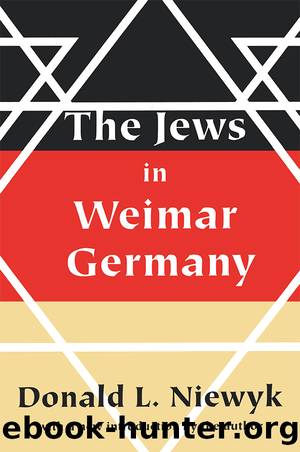Jews in Weimar Germany by Donald L. Niewyk

Author:Donald L. Niewyk [Niewyk, Donald L.]
Language: eng
Format: epub
Tags: History, Europe, General, Social Science, Regional Studies
ISBN: 9781351303620
Google: YiNHDwAAQBAJ
Publisher: Routledge
Published: 2018-01-16T03:43:40+00:00
* * *
1 Schorsch, Jewish Reactions to German Anti-Semitism, 1-12; Tal, Christians and Jews in Germany, 81-120.
2 Walther Rathenau, âHöre, Israel!â in Impressionen (Leipzig, 1902), 3-20. It first appeared in 1897 as an essay by âW. Hartenauâ in Maximilian Hardenâs Die Zukunft.
3 Berglar, Walther Rathenau, 304-307.
4 Constantin Brunner, Der Judenhass und die Juden (Berlin, 1918), 289-344. Written on the eve of World War I, its publication was delayed by the outbreak of hostilities. See also Constantin Brunner, Höre Israel und Höre Nicht-Israel (Berlin, 1931), 3-38; Constantin Brunner, Von der Pflichten der Juden und von den Pflichten des Staates (Berlin, 1930), 19-62, 159-68. Cf. Frederick Ritter, âConstantin Brunner und seine Stellung zur Judenfrage,â Bulletin des Leo Baeck Instituts, XIV (1975), 40-79.
5Willy Hellpach, Politische Prognose für Deutschland (Berlin, 1928), 373; Willy Hellpach, âRasse im deutschen Volkstum,â Mitteilungen aus dem Verein zur Abwehr des Antisemitismus, XXXVII (1927), 50-54.
6 For example, Emst Löwenberg, a Jewish teacher in Hamburg, recalled that the members of the republican political club to which he belonged saw no way out of the Jewish question short of the amalgamation of the Jews into the larger society. Ernst Löwenberg, âMein Leben in Deutschland vor und nach dem 30. Januar 1933â (Typescript in Leo Baeck Institute Archives, New York), 8.
7 Theilhaber, Der Untergang der deutschen Juden, 117-18.
8 Ruppin, Soziologie der Juden, I, 213, 224-25; Behr, Der Bevölkerungsrückgang der deutschen Juden, III; R. E. May, âDie Entwicklung der jüdischen Mischehen und ihre Wirkung auf die jüdische Gemeinschaft,â Gemeindeblatt der Deutsch-Israelitischen Gemeinde zu Hamburg, VIII (1932), 1-3. However, as a leader of the League of Jewish Women noted, official figures reflected marriages between Jews and non-Jews in a religious sense only and did not take into consideration the fact that some of them involved baptized Jews whose marriages to religious Jews brought them back to Judaism. Dora Edinger, âZur Frage der Mischehen,â Gemeindeblatt der Israelitischen Gemeinde Frankfurt a. Main, III (1925), 3.
9 The Nazi census of Jews in Germany, Austria, and the Sudetenland, made on May 17, 1939, found that 84,674 of the 330,539 âracial Jewsâ were âcross-breedsâ having only one or two Jewish grandparents. Whereas 91.5 percent of the âfull-blooded Jewsâ identified themselves as adherents of Judaism, only 6.6 percent of the âcross-breedsâ did so. Bruno Blau, âThe Jewish Population of Germany 1939-1945,â Jewish Social Studies, XII (1950), 161-72.
10 Löwenfeld, âMemoiren,â 563-68; Hermann Sinsheimer, âPaul Nikolaus Cossmann,â in Lamm (ed.), Von Juden in München, 295-97.
11 Two cases involving lesser figures that have come to light were those of Kurt Soiling, a Berlin judge and Nazi sympathizer, and Karl Kindermann, a right-wing German student arrested and executed in Russia for plotting to assassinate Trotsky. Der Israelit, June 2, 1932; M. W. [Moses Waldmann], âKindermann,â Jüdische Rundschau, August 7, 1925.
12 Central-Verein Zeitung, July 3, 1925; Paul Meyer, âZur Frage der Vertiefung der Tendenz,â K. C. Blätter, IX (1919), 8-10; Rudolf H. Heimansohn, âSind wir Assimilanten?â ibid., XXI (1931), 11-14.
13 Jakob Wassermann, Mein Weg als Deutscher und Jude (Berlin, 1921), 126.
14 Leo Baeck, âKulturzusammenhänge,â Der Morgen,
Download
This site does not store any files on its server. We only index and link to content provided by other sites. Please contact the content providers to delete copyright contents if any and email us, we'll remove relevant links or contents immediately.
Room 212 by Kate Stewart(5035)
The Crown by Robert Lacey(4722)
Endurance: Shackleton's Incredible Voyage by Alfred Lansing(4676)
The Iron Duke by The Iron Duke(4291)
The Rape of Nanking by Iris Chang(4136)
Joan of Arc by Mary Gordon(4013)
Killing England by Bill O'Reilly(3951)
Say Nothing by Patrick Radden Keefe(3903)
I'll Give You the Sun by Jandy Nelson(3357)
Shadow of Night by Deborah Harkness(3298)
Hitler's Monsters by Eric Kurlander(3268)
Mary, Queen of Scots, and the Murder of Lord Darnley by Alison Weir(3148)
Blood and Sand by Alex Von Tunzelmann(3138)
Darkest Hour by Anthony McCarten(3070)
Eleanor & Park by Rainbow Rowell(3061)
Margaret Thatcher: The Autobiography by Thatcher Margaret(3028)
Red Famine: Stalin's War on Ukraine by Anne Applebaum(2873)
Book of Life by Deborah Harkness(2867)
The One Memory of Flora Banks by Emily Barr(2801)
